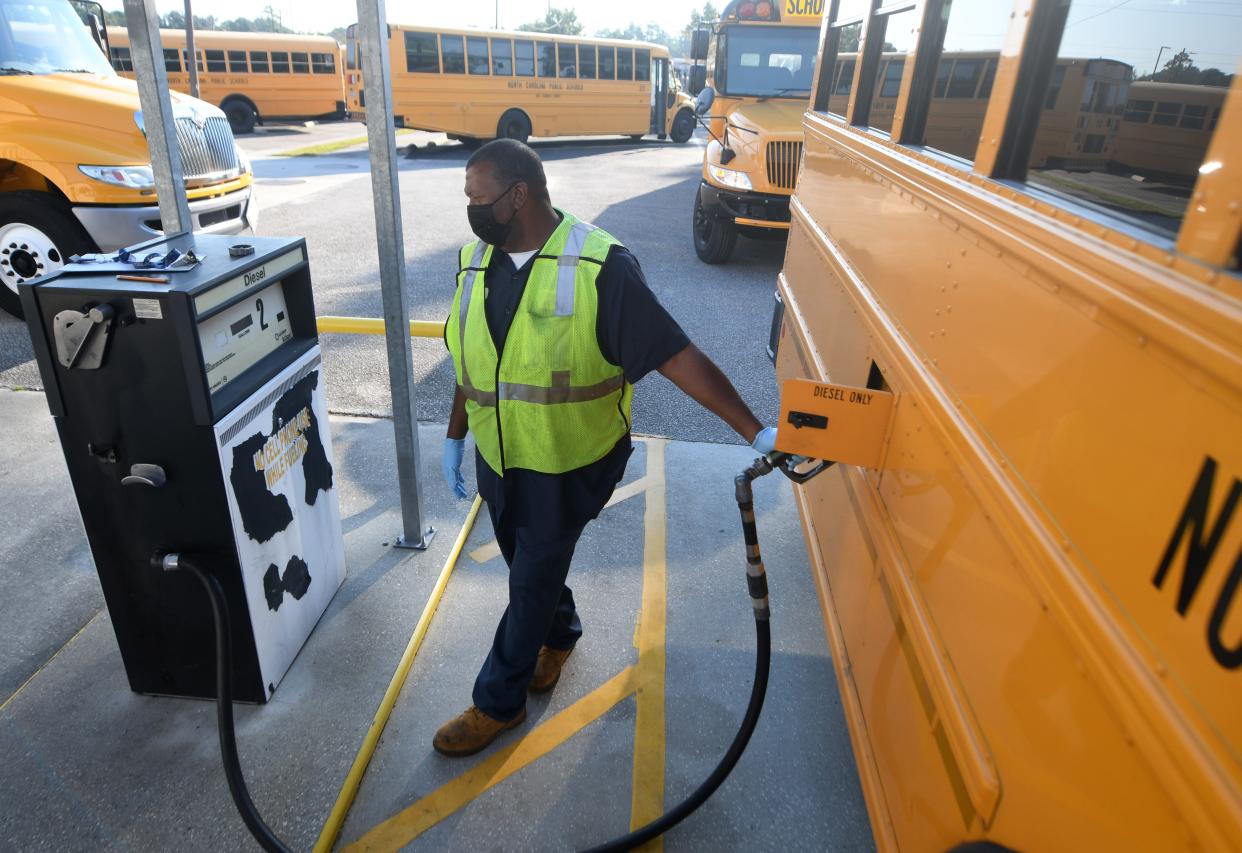Are higher fuel prices impacting school transportation in the Wilmington area?

While fuel prices skyrocketed in the past month, Wilmington-area school districts say they haven’t experienced the headaches and budget concerns other districts across the nation have when it comes to transporting students. That might not always be the case, though.
District officials in Brunswick, Pender and New Hanover County Schools said they haven’t had any problems getting fuel and so far, there haven’t been any budget shortfalls. That's because though fuel has become more expensive, overall consumption has plummeted, said Eddie Anderson, assistant superintendent of operations for New Hanover County Schools.
Anderson said the district had to make several adjustments to transportation because of the COVID-19 pandemic, the subsequent shortage in bus drivers and the decrease in ridership. That meant shortening routes while increasing the number of students on a route, which resulted in substantially lower miles driven and dollars spent on fuel throughout the school year.
"Once we made all those adjustments, we became much more efficient, making sure that our buses were as close to capacity as possible, and we're driving far fewer miles," he said.
Across the nation, schools rely on tens of millions of gallons of diesel fuel each month to transport students to and from school and activities. With prices skyrocketing in the wake of the Russian invasion in Ukraine, districts are reporting issues with maintaining a budget and getting an adequate amount of diesel fuel to manage transportation.
As of March 30, average diesel prices in the Wilmington-area were around $5 per gallon, according to AAA. That’s come down in recent weeks, with the highest diesel price recorded in Wilmington reaching around $5.10 on March 13.
Mask mandates: Judge rules in favor of New Hanover school board in mask mandate lawsuit
Student mental health: Services well below recommended level in NC, Wilmington-area schools
Sex abuse lawsuit: At court hearing, school district argues it shouldn't be held liable for teacher's abuse
Pandemic learning losses: Student reading levels plummet in wake of the COVID pandemic. Here's how schools answer back
It’s not uncommon for rising fuel prices to impact school districts – transportation departments have been hit with higher prices per gallon during hurricanes, the Great Recession in 2008, and past global conflict and wars. Most recently, some North Carolina school districts were forced to go into remote learning for a day while gas was nearly inaccessible after a ransomware attack on the Colonial Pipeline in May 2021, which caused chaos at the pumps in Wilmington and raised average national gas prices about $3 for the first time since 2016.
In North Carolina, districts get funding from the state to pay for fuel, and Anderson said that can be adjusted if gas prices fluctuate.
Before the pandemic, New Hanover County Schools logged 1.4 million miles between July 1 and Feb. 28. This school year, that's down to 1.1 million miles. In gallons of fuel, the district decreased from 262,000 gallons to 179,000, and in dollars, spending went down from $515,000 to $450,000. Anderson said even with the increase in prices, more efficient routes made up for that and allowed the district to still spend less on diesel fuel than before the pandemic.
However, officials are encouraging staff to conserve fuel where possible, and administrators continue monitoring prices for diesel fuel and estimate what they will need to preserve their budget for the remainder of the school year.
“PCS is monitoring fuel availability and pricing on a daily basis and encourages staff to conserve fuel as much as possible without disrupting daily operations,” said Pender County Schools Transportation Director Brandon Smith in an emailed statement. “We will continue to work with all stakeholders and funding sources to ensure that our student's needs are served.”
School officials in the Wilmington-area said daily operations shouldn’t be affected, despite the rise in cost. But if fuel prices don’t start going back down soon, districts may have to look for options within their budgets to make up for costly transportation.
“We are hoping DPI(NC Department of Public Instruction) adjusts our budget for the remainder of the year. If not we will probably run short on state funds and have to use local funding,” a statement from Brunswick County Schools said.
Reporter Sydney Hoover can be reached at 910-343-2339 or shoover@gannett.com.
This article originally appeared on Wilmington StarNews: Districts say rising fuel costs yet to impact school transportation

